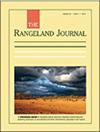The role of the locoweed (Astragalus variabilis Bunge) in improving the soil properties of desert grasslands
IF 0.9
4区 环境科学与生态学
Q4 ECOLOGY
引用次数: 2
Abstract
Astragalus variabilis Bunge is a widespread locoweed that threatens livestock production in desert grassland. No research has reported its possible ecological functions due to focus being on its negative effect on livestock production. This study aimed to assess the effects of A. variabilis on soil properties and its possible role in improving soil quality in desert grassland. Soil samples were collected in Astragalus patches and the adjacent bare patches over two successive growing seasons in Alxa desert grassland where A. variabilis was favoured to spread. Soil properties including texture, water content, dry bulk density, porosity, available nutrients, organic matter, and soil microbial biomass were determined at 15 study sites. There was no significant difference in soil texture between Astragalus-dominant and bare patches; but organic matter (OM), available N and P, and microbial biomass in surface soil (0–30 cm) were significantly higher in Astragalus patches. Furthermore, microbial biomass showed a significantly positive correlation with available nutrients and OM. Levels of water soluble salt were significantly lower in A. variabilis surface soils under drought conditions. Results suggested that A. variabilis was associated with some positive changes in soil properties, and was potentially important in improving soil chemical and microbial properties in desert grassland ecosystems. Consequently, total elimination of locoweed should not necessarily be considered the best solution to locoweed poisoning in livestock.黄芪在改善荒漠草原土壤性质中的作用
黄芪(Astragalus variabilis Bunge)是一种分布广泛的禾草植物,对荒漠草原的畜牧业生产构成威胁。由于其对畜牧业生产的负面影响,尚未有研究报道其可能的生态功能。本研究旨在探讨变异蒿对荒漠草地土壤性质的影响及其在改善土壤质量中的可能作用。在变异黄芪易蔓延的阿拉xa荒漠草地连续2个生长季节采集黄芪斑块及其相邻光斑的土壤样品。在15个研究地点测定了土壤性质,包括质地、含水量、干容重、孔隙度、有效养分、有机质和土壤微生物生物量。黄芪优势地与光斑地土壤质地差异不显著;黄芪斑块表层土壤(0 ~ 30 cm)有机质、速效氮磷和微生物生物量显著高于黄芪斑块。微生物生物量与速效养分和有机质呈极显著正相关。干旱条件下,白杨表层土壤水溶性盐含量显著降低。结果表明,变异芽孢杆菌与荒漠草地土壤性状发生了积极的变化,对改善荒漠草地生态系统土壤化学和微生物性状具有潜在的重要意义。因此,完全消灭麻草不一定被认为是解决牲畜麻草中毒的最佳办法。
本文章由计算机程序翻译,如有差异,请以英文原文为准。
求助全文
约1分钟内获得全文
求助全文
来源期刊

Rangeland Journal
环境科学-生态学
CiteScore
2.90
自引率
8.30%
发文量
14
审稿时长
>36 weeks
期刊介绍:
The Rangeland Journal publishes original work that makes a significant contribution to understanding the biophysical, social, cultural, economic, and policy influences affecting rangeland use and management throughout the world. Rangelands are defined broadly and include all those environments where natural ecological processes predominate, and where values and benefits are based primarily on natural resources.
Articles may present the results of original research, contributions to theory or new conclusions reached from the review of a topic. Their structure need not conform to that of standard scientific articles but writing style must be clear and concise. All material presented must be well documented, critically analysed and objectively presented. All papers are peer-reviewed.
The Rangeland Journal is published on behalf of the Australian Rangeland Society.
 求助内容:
求助内容: 应助结果提醒方式:
应助结果提醒方式:


